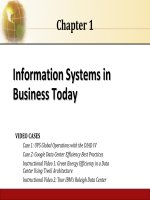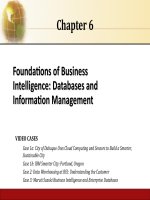Management information systems 13th laudon chapter 03
Bạn đang xem bản rút gọn của tài liệu. Xem và tải ngay bản đầy đủ của tài liệu tại đây (1.1 MB, 51 trang )
Chapter 3
Information Systems,
Organizations, and Strategy
VIDEO CASES
Case 1: National Basketball Association: Competing on Global Delivery with Akamai OS Streaming
Case 2: IT and Geo-Mapping Help a Small Business Succeed (2009)
Case 3: Materials Handling Equipment Corp: Enterprise Systems Drive Corporate Strategy for a
Small Business
Instructional Video 1 SAP BusinessOne ERP: From Orders to Final Delivery and Payment
Management Information Systems
Chapter 3: Information Systems, Organizations, and Strategy
Learning Objectives
• Identify and describe important features of
organizations that managers need to know about in
order to build and use information systems
successfully.
• Demonstrate how Porter’s competitive forces
model helps companies develop competitive
strategies using information systems.
• Explain how the value chain and value web models
help businesses identify opportunities for strategic
information system applications.
3.2
Copyright © 2014 Pearson Education, Inc.
Management Information Systems
Chapter 3: Information Systems, Organizations, and Strategy
Learning Objectives (cont.)
• Demonstrate how information systems help
businesses use synergies, core competencies,
and network-based strategies to achieve
competitive advantage.
• Assess the challenges posed by strategic
information systems and management
solutions.
3.3
Copyright © 2014 Pearson Education, Inc.
Management Information Systems
Chapter 3: Information Systems, Organizations, and Strategy
Will Sears’s Technology Strategy Work This Time?
• Problem: Fading brand, powerful
competitors, technology costs
• Solutions:
– Customer data mining to improve customer
intimacy, design sales floors, implement
customer programs and promotions
• Demonstrates IT’s central role in defining
competitive strategy
3.4
Copyright © 2014 Pearson Education, Inc.
Management Information Systems
Chapter 3: Information Systems, Organizations, and Strategy
Organizations and Information Systems
• Information technology and organizations
influence each other
– Relationship influenced by organization’s
• Structure
• Business processes
• Politics
• Culture
• Environment
• Management decisions
3.5
Copyright © 2014 Pearson Education, Inc.
Management Information Systems
Chapter 3: Information Systems, Organizations, and Strategy
THE TWO-WAY RELATIONSHIP BETWEEN ORGANIZATIONS AND INFORMATION TECHNOLOGY
This complex two-way
relationship is mediated by
many factors, not the least of
which are the decisions made
—or not made—by managers.
Other factors mediating the
relationship include the
organizational culture,
structure, politics, business
processes, and environment.
FIGURE 3-1
3.6
Copyright © 2014 Pearson Education, Inc.
Management Information Systems
Chapter 3: Information Systems, Organizations, and Strategy
Organizations and Information Systems
• What is an organization?
– Technical definition:
• Formal social structure that processes resources from
environment to produce outputs
• A formal legal entity with internal rules and
procedures, as well as a social structure
– Behavioral definition:
• A collection of rights, privileges, obligations, and
responsibilities that is delicately balanced over a period
of time through conflict and conflict resolution
3.7
Copyright © 2014 Pearson Education, Inc.
Management Information Systems
Chapter 3: Information Systems, Organizations, and Strategy
THE TECHNICAL MICROECONOMIC DEFINITION OF THE ORGANIZATION
FIGURE 3-2
3.8
In the microeconomic definition of organizations, capital and labor (the primary production factors provided by
the environment) are transformed by the firm through the production process into products and services
(outputs to the environment). The products and services are consumed by the environment, which supplies
additional capital and labor as inputs in the feedback loop.
Copyright © 2014 Pearson Education, Inc.
Management Information Systems
Chapter 3: Information Systems, Organizations, and Strategy
THE BEHAVIORAL VIEW OF ORGANIZATIONS
The behavioral view of
organizations
emphasizes group
relationships, values,
and structures.
FIGURE 3-3
3.9
Copyright © 2014 Pearson Education, Inc.
Management Information Systems
Chapter 3: Information Systems, Organizations, and Strategy
Organizations and Information Systems
• Features of organizations
• Use of hierarchical structure
• Accountability, authority in system of impartial
decision making
• Adherence to principle of efficiency
• Routines and business processes
• Organizational politics, culture, environments,
and structures
3.10
Copyright © 2014 Pearson Education, Inc.
Management Information Systems
Chapter 3: Information Systems, Organizations, and Strategy
Organizations and Information Systems
• Routines and business processes
• Routines (standard operating procedures)
• Precise rules, procedures, and practices
developed to cope with virtually all
expected situations
• Business processes: Collections of routines
• Business firm: Collection of business
processes
3.11
Copyright © 2014 Pearson Education, Inc.
Management Information Systems
Chapter 3: Information Systems, Organizations, and Strategy
ROUTINES, BUSINESS PROCESSES, AND FIRMS
All organizations are composed
of individual routines and
behaviors, a collection of which
make up a business process. A
collection of business processes
make up the business firm.
New information system
applications require that
individual routines and
business processes change to
achieve high levels of
organizational performance.
FIGURE 3-4
3.12
Copyright © 2014 Pearson Education, Inc.
Management Information Systems
Chapter 3: Information Systems, Organizations, and Strategy
Organizations and Information Systems
• Organizational politics
• Divergent viewpoints lead to political
struggle, competition, and conflict.
• Political resistance greatly hampers
organizational change.
3.13
Copyright © 2014 Pearson Education, Inc.
Management Information Systems
Chapter 3: Information Systems, Organizations, and Strategy
Organizations and Information Systems
• Organizational culture:
• Encompasses set of assumptions that
define goal and product
• What products the organization should produce
• How and where it should be produced
• For whom the products should be produced
• May be powerful unifying force as well as
restraint on change
3.14
Copyright © 2014 Pearson Education, Inc.
Management Information Systems
Chapter 3: Information Systems, Organizations, and Strategy
Organizations and Information Systems
• Organizational environments:
• Organizations and environments have a reciprocal
relationship.
• Organizations are open to, and dependent on, the
social and physical environment.
• Organizations can influence their environments.
• Environments generally change faster than
organizations.
• Information systems can be instrument of
environmental scanning, act as a lens.
3.15
Copyright © 2014 Pearson Education, Inc.
Management Information Systems
Chapter 3: Information Systems, Organizations, and Strategy
ENVIRONMENTS AND ORGANIZATIONS HAVE A RECIPROCAL RELATIONSHIP
FIGURE 3-5
3.16
Environments shape what organizations can do, but organizations can influence their environments and decide
to change environments altogether. Information technology plays a critical role in helping organizations
perceive environmental change and in helping organizations act on their environment.
Copyright © 2014 Pearson Education, Inc.
Management Information Systems
Chapter 3: Information Systems, Organizations, and Strategy
Organizations and Information Systems
• Disruptive technologies
– Technology that brings about sweeping change
to businesses, industries, markets
– Examples: personal computers, word processing
software, the Internet, the PageRank algorithm
– First movers and fast followers
• First movers—inventors of disruptive
technologies
• Fast followers—firms with the size and
resources to capitalize on that technology
3.17
Copyright © 2014 Pearson Education, Inc.
Management Information Systems
Chapter 3: Information Systems, Organizations, and Strategy
Organizations and Information Systems
• 5 basic kinds of organizational structure
– Entrepreneurial:
• Small start-up business
– Machine bureaucracy:
• Midsize manufacturing firm
– Divisionalized bureaucracy:
• Fortune 500 firms
– Professional bureaucracy:
• Law firms, school systems, hospitals
– Adhocracy:
• Consulting firms
3.18
Copyright © 2014 Pearson Education, Inc.
Management Information Systems
Chapter 3: Information Systems, Organizations, and Strategy
Organizations and Information Systems
• Other organizational features
– Goals
• Coercive, utilitarian, normative, and so
on
3.19
– Constituencies
– Leadership styles
– Tasks
– Surrounding environments
Copyright © 2014 Pearson Education, Inc.
Management Information Systems
Chapter 3: Information Systems, Organizations, and Strategy
How Information Systems Impact Organizations and Business Firms
• Economic impacts
– IT changes relative costs of capital and the costs of
information
– Information systems technology is a factor of
production, like capital and labor
– IT affects the cost and quality of information and
changes economics of information
• Information technology helps firms contract in size
because it can reduce transaction costs (the cost of
participating in markets)
– Outsourcing
3.20
Copyright © 2014 Pearson Education, Inc.
Management Information Systems
Chapter 3: Information Systems, Organizations, and Strategy
How Information Systems Impact Organizations and Business Firms
• Transaction cost theory
– Firms seek to economize on transaction costs
(the costs of participating in markets).
• Vertical integration, hiring more employees,
buying suppliers and distributors
– IT lowers market transaction costs for firm,
making it worthwhile for firms to transact with
other firms rather than grow the number of
employees.
3.21
Copyright © 2014 Pearson Education, Inc.
Management Information Systems
Chapter 3: Information Systems, Organizations, and Strategy
How Information Systems Impact Organizations and Business Firms
• Agency theory:
– Firm is nexus of contracts among self-interested
parties requiring supervision.
– Firms experience agency costs (the cost of
managing and supervising) which rise as firm
grows.
– IT can reduce agency costs, making it possible for
firms to grow without adding to the costs of
supervising, and without adding employees.
3.22
Copyright © 2014 Pearson Education, Inc.
Management Information Systems
Chapter 3: Information Systems, Organizations, and Strategy
How Information Systems Impact Organizations and Business Firms
• Organizational and behavioral impacts
– IT flattens organizations
• Decision making is pushed to lower levels.
• Fewer managers are needed (IT enables faster
decision making and increases span of control).
– Postindustrial organizations
• Organizations flatten because in postindustrial
societies, authority increasingly relies on
knowledge and competence rather than formal
positions.
3.23
Copyright © 2014 Pearson Education, Inc.
Management Information Systems
Chapter 3: Information Systems, Organizations, and Strategy
FLATTENING ORGANIZATIONS
Information systems can reduce
the number of levels in an
organization by providing
managers with information to
supervise larger numbers of
workers and by giving lowerlevel employees more decisionmaking authority.
FIGURE 3-6
3.24
Copyright © 2014 Pearson Education, Inc.
Management Information Systems
Chapter 3: Information Systems, Organizations, and Strategy
How Information Systems Impact Organizations and Business Firms
• Organizational resistance to change
– Information systems become bound up in
organizational politics because they influence
access to a key resource—information.
– Information systems potentially change an
organization’s structure, culture, politics, and
work.
– Most common reason for failure of large projects
is due to organizational and political resistance to
change.
3.25
Copyright © 2014 Pearson Education, Inc.









